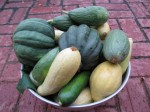 Most vegetables need a good supply of nutrients to produce a hefty crop. If your soil is very rich and fertile, they may do well with out any additions but most gardens are not so lucky and fertilizer must be added. Some vegetables are happy with one application of a balanced fertilizer before or at planting time but others need additional applications especially of nitrogen.
Most vegetables need a good supply of nutrients to produce a hefty crop. If your soil is very rich and fertile, they may do well with out any additions but most gardens are not so lucky and fertilizer must be added. Some vegetables are happy with one application of a balanced fertilizer before or at planting time but others need additional applications especially of nitrogen.
All green plants need nitrogen in order to produce leaves because it is a critical component of chlorophyll, the pigment that makes leaves green and enables them to produce food for flower, fruit, and seed production. Some plants seem to be able to produce flowers and fruits on small quantities of nitrogen but others need a lot. Unfortunately, nitrogen washes out of the soil easily and quickly so that every time you water or it rains, nitrogen is lost. To make matters worse, sandy soil loses nitrogen even more quickly than heavier soils and needs more frequent additions. All this adds up to the fact that you have to supply nitrogen on a regular basis through out the growing season to many crops. This is called side dressing. Generally speaking, long season rapidly growing crops such as tomatoes and eggplant need one or more side dressings every year.
Here are some suggestions for fertilizing some common vegetables. Granular or liquid fertilizer may be used but granular with the right chemical make-up is probably easier to find.
1. Good soil preparation: Add a balanced fertilizer such as 8-8-8 or 10-10-10 (nitrogen, phosphorus, potash respectively) to the soil a couple of weeks before planting using the manufactures suggested rates (about 20-30 pounds per 1000 square feet).
2. Side dressing: Add ¼ cup 8-8-8 or 10-10-10 about 4-6 inches on either side of the an individual plant or in a furrow made along the row of plants as follows.
 Asparagus: early spring before growth begins
Asparagus: early spring before growth begins
 Broccoli, cabbage and cauliflower: 3 weeks after transplanting
Broccoli, cabbage and cauliflower: 3 weeks after transplanting
 Eggplant, pepper, tomato and squash: 3 weeks after planting, at flowering, and at the beginning of fruit set.
Eggplant, pepper, tomato and squash: 3 weeks after planting, at flowering, and at the beginning of fruit set.
 Cucumber and melon: as the vines begin to run and at flowering
Cucumber and melon: as the vines begin to run and at flowering
 Corn: 3 weeks after planting; when plants are 8-10” high; and when tasseling begins.
Corn: 3 weeks after planting; when plants are 8-10” high; and when tasseling begins.
 Onion: 4-6 weeks after planting.
Onion: 4-6 weeks after planting.
 Potato: At last hilling, before they start to blossom.
Potato: At last hilling, before they start to blossom.
Most other vegetables do not need a side dressing if a balanced fertilizer has been added to the soil as suggested in item 1.
3. Watering: Always water before and after applying fertilizer to prevent burning and increase the movement of nutrients to the roots of the plants.
4. Weather: Don’t fertilize with a granular fertilizer during drought as the plant can’t use the nutrients without moisture in the soil; likewise, in cool weather plants don’t grow as rapidly and will not use nutrients as quickly as usual.
5. Over fertilizing: Adding more fertilizer than necessary can be harmful. The excess can accumulate in the soil and damage the plants or enter the ground water and become part of the pollution problem. In addition, nitrogen can cause abundant leaf growth at the expense of flower and fruit production. This is a good thing for cabbage, lettuce and kale but not for tomatoes, peppers or squash.
6. Slow Release Fertilizer: If you choose a slow release fertilizer you may not have to side dress as often but you also will not get the same results. Slow release fertilizers provide nutrients for 3-4 months at a constant rate that does not necessarily coincide with the needs of many plants, such as tomatoes or squash so you may get more leaves and less fruit.
Fertilizing your vegetable garden is an important step in having a successful and abundant crop. Plan a head, watch the daily development of your individual crops, and take action as the plants needs change. The proper fertilizing regime is not difficult but does require some attention to detail effort and every minute you spend is worth it when you load up the wheel barrel with freshly picked vegetables.
